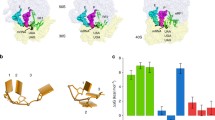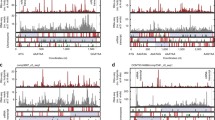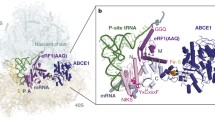Abstract
In species with variant genetic codes, one or two stop codons encode amino acid residues and are not recognized by the intrinsic class I translation termination factor (eRF1). Ciliata include a large number of species with variant genetic codes. The stop codon specificity of the Blepharisma japonicum translation termination factor eRF1 was determined in an in vitro eukaryotic translation system and in an in vivo assay (a dual reporter system). It was shown that eRF1 of B. japonicum retained specificity to all three stop codons, although the efficiency of peptydyl-tRNA hydrolysis in the presence of UGA was reduced in the in vitro assay. Since Heterotrichea (including B. japonicum) are the earliest diverged lineage in the phylogenetic tree of ciliates, B. japonicum probably possesses a universal genetic code similar to the putative ciliate ancestor group.
Similar content being viewed by others
References
Kisselev L., Ehrenberg M., Frolova L. 2003. Termination of translation: Interplay of mRNA, rRNAs release factors. EMBO J. 22, 175–182.
Nakamura Y., Ito K. 2003. Making sense of mimic in translation termination. Trends Biochem. Sci. 28, 99–105.
Poole E.S., Askarian-Amiri M.E., Major L.L., McCaughan K.K. Scarlet D.J., Wilson D.N., Tate W.P. 2003. Molecular mimicry in the decoding of translational stop signals. Prog. Nucl. Acids Res. Mol. Biol. 74, 83–121.
Inagaki Y., Doolittle W.F. 2001. Class 1 release factors in ciliates with variant genetic codes. Nucleic Acids Res. 29, 921–927.
Lozupone C.A., Knight R.D., Landweber L.F. 2001. The molecular basis of nuclear genetic code change in ciliates. Curr. Biol. 11, 65–74.
Ohama T., Inagaki Y., Bessho Y., Osawa S. 2008. Evolving genetic code. Proc. Jpn. Acad. Ser. B: Phys. Biol. Sci. 84, 58–74.
Turanov A.A., Lobanov A.V., Fomenko D.E., Morrison H.G., Sogin M.L., Klobutcher L.A., Hatfield D.L., Gladyshev V.N. 2009. Genetic code supports targeted insertion of two amino acids by one codon. Science. 323, 259–261.
Lekomtsev S., Kolosov P., Bidou L., Frolova L., Rousset J.P., Kisselev L. 2007. Different modes of stop codon restriction by the Stylonychia and Paramecium eRF1 translation termination factors. Proc. Natl. Acad. Sci. U. S. A. 104, 10824–10829.
Kervestin S., Frolova L., Kisselev L., Jean-Jean O. 2001. Stop codon recognition in ciliates: Euplotes release factor does not respond to reassigned UGA codon. EMBO Rep. 2, 680–684.
Salas-Marco J., Fan-Minogue H., Kallmeyer A.K., Klobutcher L.A., Farabaugh P.J., Bedwell D.M. 2006. Distinct paths to stop codon reassignment by the variant-code organisms Tetrahymena and Euplotes. Mol. Cell Biol. 26, 438–447.
Lekomtsev S.A., Kolosov P.M., Frolova L.Yu., Bidou L., Rousset J.-P., Kisselev L.L. 2007. How does Euplotes translation termination factor eRF1 fail to recognize the UGA stop codon? Mol. Biol. (Moscow). 41, 924–931.
Eliseev B., Kryuchkova P., Alkalaeva E., Frolova L. 2011. A single amino acid change of translation termination factor eRF1 switches between bipotent and omnipotent stop-codon specificity. Nucleic Acids Res. 39, 599–608.
Liang A., Heckmann K. 1993. Blepharisma uses UAA as a termination codon. Naturwissenschaften. 80, 225–226.
Wang W., Chai B., Heckmann K., Liang A. 2004. Cloning, characterization and expression of the polypeptide release factor gene, eRF1, of Blepharisma japonicum. Biotechnol. Lett. 26, 959–963.
Kim O.T., Yura K., Go N., Harumoto T. 2005. Newly sequenced eRF1s from ciliates: The diversity of stop codon usage and the molecular surfaces that are important for stop codon interactions. Gene. 346, 277–286.
Alkalaeva E.Z., Pisarev A.V., Frolova L.Y., Kisselev L.L., Pestova T.V. 2006. In vitro reconstitution of eukaryotic translation reveals cooperativity between release factors eRF1 and eRF3. Cell. 125, 1125–1136.
Frolova L.Y., Merkulova T.I., Kisselev L.L. 2000. Translation termination in eukaryotes: Polypeptide release factor eRF1 is composed of functionally and structurally distinct domains. RNA. 6, 381–390.
Cassan M., Delaunay N., Vaquero C., Rousset J.P. 1994. Translational frameshifting at the gag-pol junction of human immunodeficiency virus type 1 is not increased in infected T-lymphoid cells. J. Virol. 68, 1501–1508.
Nguyen V.T., Morange M., Bensaude O. 1988. Firefly luciferase luminescence assays using scintillation counters for quantitation in transfected mammalian cells. Anal. Biochem. 171, 404–408.
Bidou L., Stahl G., Hatin I., Namy O., Rousset J.P., Farabaugh P.J. 2000. Nonsense-mediated decay mutants do not affect programmed −1 frameshifting. RNA. 6, 952–961.
Tourancheau F.D., Tsao N., Klobutcher L.A., Pearlman R.E., Adoutte A. 1995. Genetic code deviations in the ciliates: Evidence for multiple and independent events. EMBO J. 14, 3262–3267.
Author information
Authors and Affiliations
Corresponding author
Additional information
Dedicated to the memory of Lev Kiselev
Original Russian Text © B.D. Eliseev, E.Z. Alkalaeva, P.N. Kryuchkova, S.A. Lekomtsev, Wei Wang, Ai-Hua Liang, L.Yu. Frolova, 2011, published in Molekulyarnaya Biologiya, 2011, Vol. 45, No. 4, pp. 668–672.
Rights and permissions
About this article
Cite this article
Eliseev, B.D., Alkalaeva, E.Z., Kryuchkova, P.N. et al. Translation termination factor eRF1 of the ciliate Blepharisma japonicum recognizes all three stop codons. Mol Biol 45, 614–618 (2011). https://doi.org/10.1134/S0026893311040030
Received:
Accepted:
Published:
Issue Date:
DOI: https://doi.org/10.1134/S0026893311040030




